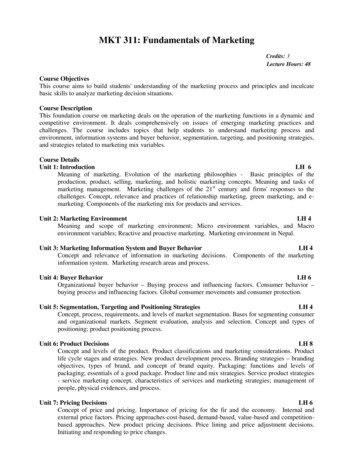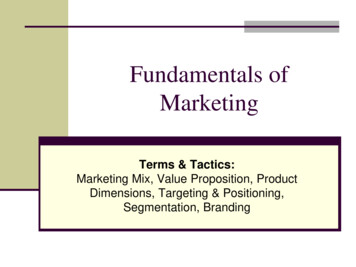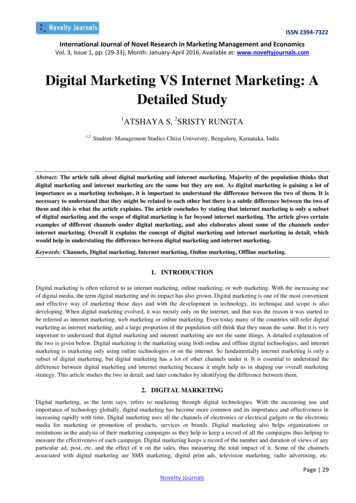
Transcription
MARKETING 101:THE FUNDAMENTALS
MARKETINGESSENTIALS
WHAT IS MARKETING? Most people mistakenly identify marketing with selling andpromotion. While selling and promotion are a part of marketing, they arenot most important part. In the Principles of Marketing by Philip Kotlet stated:o If the marketer does a good job of identifying consumerneeds, developing appropriate products, and pricing,distributing, and promoting then effectively, these goalswill sell very early.
GOODS, SERVICES, AND IDEAS Marketing deals with goods, services, and ideas. A good is something someone can touch. A service is providing an intangible benefit to customers. An idea can include concepts or images. A product refers to goods, services, and ideas.
NEEDS, WANTS, AND DEMANDS One of the underlying concepts of marketing is trying to satisfya customer’s needs, wants, and demands. Needs are plentiful. Basic human needs include food, clothing,warmth, safety and belonging. Wants are simply needs shaped by culture and the individual. Demands are simply the wants of a consumer when backed bythe ability to pay for that want.
DYNAMIC MARKETINGENVIRONMENT There are many forces that affect the marketing environment,including:o Competitiono Laws and Regulationso Economic and Social Conditionso Cultural Factors These forces can be dramatic and difficult to predict. Be aware of these forces because they can create threats andgenerate opportunities for your business.
THE MARKETING MIX The marketing mix is another important concept when it comesto marketing. The marketing mix refers to activities that a firm can control toproduct the response it wants from the target market. These variables can be categorized into four groups, also knowas the four P’s of marketing.
THE 4 P’s OF MARKETING1. Product – This is what you are offering to your target market,be it a tangible product or a service.2. Price – The amount you will charge for your product3. Place – Channels your product will go through to reach thecustomer.4. Promotion – How you raise awareness with your target market.
THE 5TH P OF MARKETING While the previous four P’s are important to the marketing mix,there is one that is left out. Positioning Positioning is not dealing with where you will place yourproduct in the market, but where you will place your product inthe mind of the consumer
RESEARCHGUIDELINES
MARKETING RESEARCH DATA There are two main types of data thatwill help you in researching yourmarket The first is secondary data which isthe information that already existssomewhere. It was collected foranother purpose. Primary data consists of informationcollected for the specific purpose athand.
START WITH SECONDARY DATA Researchers will usually start by collectingsecondary data. Secondary data can be obtained quickerand at lower costs. When collection secondary data, evaluateit carefully to make sure that it is:o Relevanto Accurateo Currento Impartial
RESEARCHING YOUR INDUSTRY With all the resource outlets that existstoday, there are many opportunities for youto gather secondary information on theindustry you will be participating in. The following sources should help you ingetting started:o National Statistical Coordination Board –www.nscb.gov.pho National Statistics Office – www.census.gov.pho National Economic & Development Authority –www.nedga.gov.pho Trade associations
RESEARCHING CUSTOMER Before you start researching yourcustomer, it is important that youdetermine whether they will beindividuals in a particular area or ifthey will be other businesses.
RESEARCHING CONSUMERS There are many secondary datasources for researching consumers:o National Econominc &Development Authority (NEDA)o National Statistics Office (NSO)
RESEARCHING BUSINESSES If your target customers are otherbusinesses, the following links may behelpful in conducting research:o National Statistics Office (NSO)o Bureau of Internal Revenue (BIR) –www.bir.gov.ph
ESTIMATING YOUR MARKET SIZE After you have determined who yourcustomer will be and found some oftheir characteristics, you need toestimate the size of your targetmarket. BIR, Census, NEDA and DTI Data Kitof Official Philippine Statistics are allsources that can help you estimateyou target size
1ST PPRODUCTS
WHAT IS IT THAT YOU SELL? One of the first questions to ask yourself is whatdoes your product do? Other questions that you should address are:o What need is addressed by the product?o What are its features and benefits?o Who supplies the products or materials? Whether you make or resell a product, thesequestions are important to answer.
PACKAGING YOUR PRODUCT After you have addressed questions about your product, youshould then consider how you will package it. The primary function of packaging use to be to hold and protectthe product. Many decisions are needed about the packaging – size, shape,color, material, and label. Be sure that the packaging is consistent with the product you areoffering. Run engineering, visual and consumer tests when developing thepackaging.
PRODUCT MIX While some companies only offer one product orservice, most companies try to diversifythemselves by offering product mix. A product mix is the set of all product lines anditems that a particular seller offers to buyers.
2ND PPRICE
PRICING DECISIONS There are a number of internal and externalfactors that will come into play when settingprices. Some of the internal factors may include pricingobjectives, strategy and costs. External factors may include nature of marketand demand, competition and the economy.
PRICING OBJECTIVES Pricing objectives help answer the question:What are you trying to achieve with your pricingstrategy?o Survivalo Profito Return on Investmento Market Shareo Cash Flowo Status Quo
PRICING STRATEGY Once you have determined your objectives, youshould then focus on the methods you will use todetermine your prices. Keep in mind laws that regulate pricing andpricing strategies such as the Philippine Price Act– Republic Act No. 7581(dtiner.ph/files/LawsAndPolices-Price Act.pdf.)
TYPES OF PRICING STRATEGIES There are several basic pricing strategies:o Skim Pricing – Set you price high with the goal ofcapturing short-term profits.o Penetration Pricing – Set your price low to discouragecompetition and appeal to a larger market segment.o Fixed Pricing – Price is set by manufacturer ormiddleman and not subject to negotiation.o Variable Pricing – Price is negotiated between buyerand seller.o Price Lining – Established only a few prices for all theitems within a given product line.o Keystone Pricing – Percentage mark-up applied to theproduct cost.
3RD PPLACE
PLACING DECISIONS Placing your product is the third of the four P’s. It encompasses channels of distribution thatserve as a transporter for getting your product toyour customers. Decisions you will need to make in placing yourproduct include market coverage, channelmember selection, logistics, and location.
MARKET COVERAGE You must first determine which markets you aregoing to reach and with what objectives. Be sure to include items such as the desired levelof service and functions to be performed bychannel members. Constraints to developing your objectives maycome from several sources.
PART OF THE PROCESS What part of the distribution process does yourbusiness handle, if any?o Warehousingo Order processingo Inventory managemento Packagingo Materials handlingo Receivingo Transportation and shipping
LOCATION OF YOURBUSINESS An important decision that you need to make iswhere will your business be located. Make sure the location you select fulfills theneeds of your business; location needs, spaceneeds, accessibility, etc. Also check to see what traffic counts the facilityexperience.
4TH PPROMOTION
PROMOTIONAL MIX The promotional mix consists of four main tools:o Advertising,o Personal selling,o Sales promotion ando Publicity By identifying these tools you will be able to layout the basis of a media plan and promotionalbudget for your company
SETTING THEPROMOTIONAL BUDGET Many companies set their budget as a percentageof current or forecasted sales. While other companies mirror their budget tothat of their competitors. Still some companies will approximate theirbudget by how much the objectives they wish tomeet will cost in advertising price.
WHY HAVE A FORMAL PLAN? Many entrepreneurs insist that hustle is all that isrequired in the marketing of their business. But energy alone is not enough. Energy must bedirected by intelligence. Intelligent marketing is marketing that is first andforemost focused on a core idea.
THE PLAN’S STRUCTURE A complete marketing plan includes the followingthree sections:o The marketing plan identifies the market andyour strategy.o The creative plan is similar to the marketingplan but is limited to the content of yourmarketing materials.o The media plan which sets forth and details’syour selected media weapons and mediacalendar.
5TH PPOSITIONING
WHAT IS POSITIONING? The concept is really about positioning of aproduct in the mind of the customer. Strategy istherefore planned in the mind, not themarketplace. The approach is needed because consumers arebombarded with a continuous stream of highvolume of advertising. The consumer’s mind reacts to this high volumeof advertising by accepting only what isconsistent with prior knowledge or experience.
HOW POSITIONING WORKS It is quite difficult to change a consumer’s impressiononce it is formed. Consumers cope with information overload byoversimplifying and are likely to skirt out anythinginconsistent with their knowledge and experience. In an over-communicated environment,advertiser should present a simplified messagemake that message consistent with whatconsumer already believes by focusing onperceptions of the consumer rather than onreality of the productstheandthethethe
APPLYING POSITIONING The concept of positioning applies to products inthe broadest sense. Services, your business itself, tourist destinations,countries, and even careers can benefit from awell developed positioning strategy that focuseson a niche that is unoccupied in the mind of theconsumer or decision-maker.
TO POSITION YOUR PRODUCT Ask yourself, “How can I be the first to claim aunique position in the mind of my customer?” What exactly is my positioning message? Remember, your customer’s mind reacts byaccepting only what is consistent with their priorknowledge or experience.
A complete marketing plan includes the following three sections: o The marketing plan identifies the market and your strategy. o The creative plan is similar to the marketing plan but is limited to the content of your marketing materials. o The media plan which sets forth and details's your selected media weapons and media calendar.










